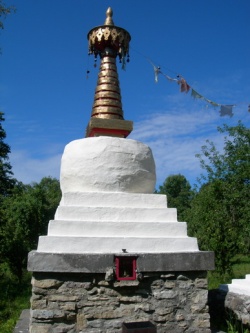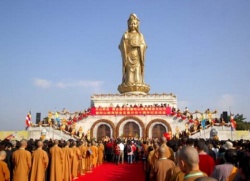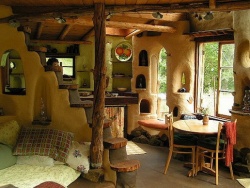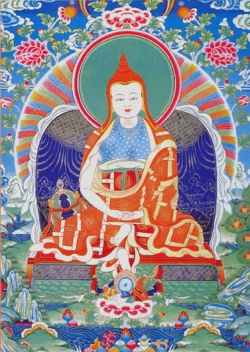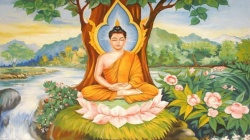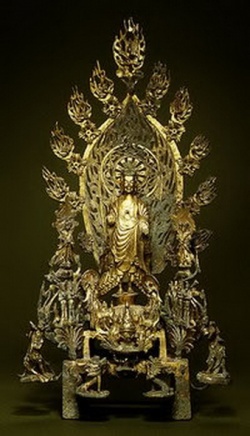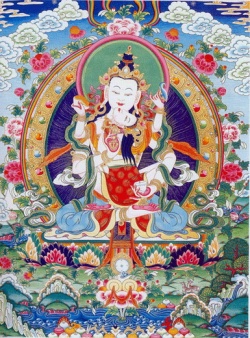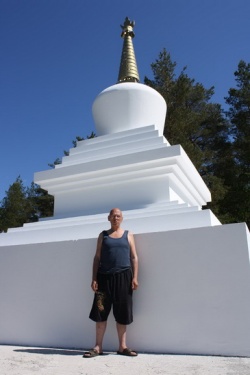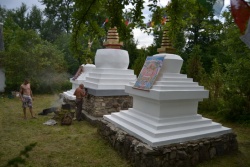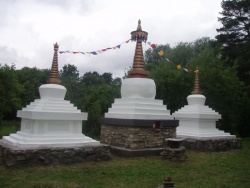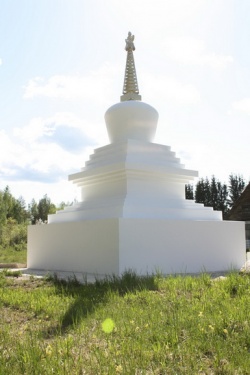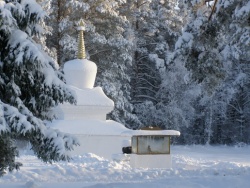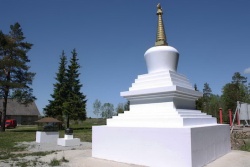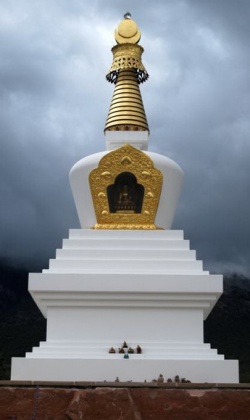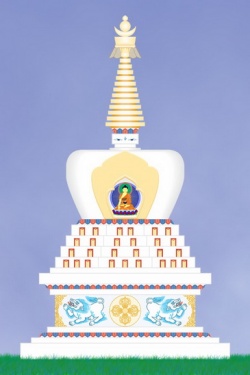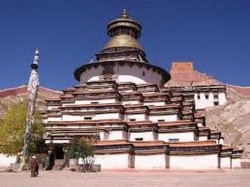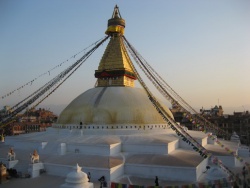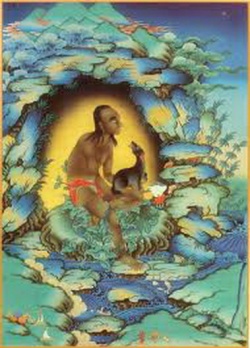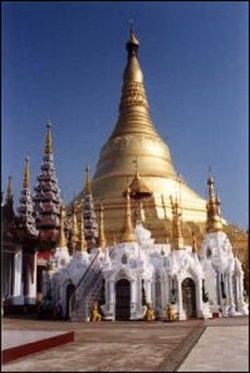The Cosmology of the Buddhist Stupa
A teaching given May 14, 2003, when initiating the building of the Amitabha Stupa in Sedona
Initially, before offering the teaching on the Dharma, that is today’s topic, which is a discussion on the meaning of the stupa. Rinpoche would like to first offer homage to the Three Jewels, that is, the Supreme Guide, the Unsurpassed Guide, the Buddha, the Holy Dharma, which are the teachings that the Buddha taught and then also the followers of the teaching, the Sangha. And so, Rinpoche would like to offer his homage to those three. And then, also specially, the Unsurpassed Guide, who is his own personal teacher, who is the embodiment of all of those three in one single form.
Rinpoche is offering this teaching on the meaning of a stupa in accord with Jetsunma’s wishes. Before he gives that teaching, he would like to extend his very warm Tashi Delek and greetings to everybody who is here attending this talk. So, Tashi Delek.
That which is known as a stupa, in Tibetan it is a chorten. A chorten actually means a receptacle of offerings. A stupa actually represents an outward expression of the Buddha’s enlightened body, speech and mind. First of all, we have the Buddha’s mind. The Buddha’s mind is such that it is non-composite phenomena. It has neither shape nor color, but it is all knowing. It is cognizant, which is lucid and yet you cannot identify it as being anything whatsoever.
But despite the fact that the Buddha’s mind is not a composite phenomena, or any thing whatsoever, it is unelaborated, cognizant and yet, in order to address the predicament that all sentient beings find themselves in, the variety of sentient beings, in order to tame those beings, bring them on the path to enlightenment, the Buddha has manifested in two specific forms in an effortless manner, in a non-artificial, sort of natural, he manifests in these two types of bodies.
That state of the pure potentiality of enlightenment, that is the state of being a Buddha, is something, which is beyond any kind of representation. It is beyond having colors or a shape or a size or any kind of form, and that authentic state of enlightenment, which is yet to manifest, is the genuine stupa, it is the genuine stupa of basic space, or you could say cho kyi ying, which means the sphere of Dharma, the sphere of pure potential. So, that is what is known as the authentic stupa before the onset of manifestation. So it is the potentiality. So that is the actual state of enlightenment that we are talking about there, before it is actually manifest.
But this state of basic space that is the Dharmadhatu is such that there is the dynamic display of that, which arises as appearances, which are unhindered. So, that space manifests this dynamic display of appearances, which are spontaneously present and complete and perfect.
And so, in this manner, because that basic space is an unhindered display of dynamic energy, then we have in the four directions, a variety of stupas manifest in order to benefit beings.
The state of the Buddha’s mind is such that it has the 32 qualities of enlightenment. They are things like the ten powers and the ten states of fearlessness and so on. There are all of these attributes of the enlightened mind of the Buddha. Those are called the qualities of the enlightened mind.
Those 32 qualities of the enlightened mind of the Buddha, when they outwardly manifest, they manifest as the 32 characteristics of a physical stupa. So, they are actually a physical representation of those internal qualities of the Buddha’s mind.
Stupas can be roughly divided into two categories. There is the category of the Theravada stupas, or the Hinayana stupa and there is the stupas in accord with the Mahayana tradition. But then there are further subdivisions of those stupas, different shapes and designs.
In the Hinayana tradition, there would be stupas that are roughly in the shape of the Buddha’s body, some in the shape of his robes, some in the shape of his alms bowl, his begging bowl and some in the shape of his throne, so there are different renditions. And then there is the staff; some stupas are in the shape of a staff.
And then in the Mahayana tradition, there are what are known as the eight principle stupas. At the time after the Buddha was cremated, his relics were divided into eight piles and given to eight different great kings and then they made stupas for those different relics. And according to the great teacher, Nagarjuna, there are eight principle stupas that perform eight different functions.
These eight principle stupas, the Mahayana tradition, commemorate the great deeds of the Buddha’s life, from the time when he was born till his passing into nirvana. So, for example, there is a stupa that commemorates his birth, that moment just after his birth when he took seven steps in the four directions and each time he took a step, a lotus flower automatically blossomed under his foot, where he placed his foot at that step. And so, there is a stupa that commemorates that, the birth of the Buddha.
And then there is a stupa that commemorates the fact that the Buddha studied a whole variety of topics in his youth and mastered them all. There is another stupa called the auspicious many-gated stupa, the Tashi Gomang stupa. That celebrates the fact that the Buddha descended back down from Tushita Pure Land, where he was teaching his mother.
And then in the Vajrayana tradition, the tantric vehicle, there are specific stupas that accomplish particular purpose. For example, there are the four main types of stupas for pacification. Some are to magnetize. Some are to increase, increase prosperity and merit and some are to magnetize. Others are for more wrathful activities.
So, there are different shapes that the stupa can adopt, but the fundamental meaning is the same in that they represent the enlightened body, speech and mind of the Buddha.
Out of the various representations that a Buddha may adopt, different representations of his enlightened body, speech and mind, the stupa, though, primarily represents the enlightened mind of the Buddha.
You might wonder, well, is this tradition of erecting stupas something that stems from the historical Buddha Shakyamuni. If you really to investigate it, you would find, actually, there are stupas that appeared prior to Buddha Shakyamuni. During the time of the third Buddha, Dipankara, there were numerous stupas erected, so it is something that is prior to Shakyamuni Buddha. There is a long history of stupa making in this world.
For example, there is a very famous stupa in the Katmandu Valley at Svayambhu. Svayambhu means the “Spontaneously Self-Arisen” stupa. During the time of the second Buddha, Marme-dze, that stupa was said to have dwelled in the sky, on the top of the mountain, so it was floating in space. And then during the time of the third Buddha, Dipankara, the stupa went below the ground. And then during the fourth Buddha, Shakyamuni Buddha, the most recent Buddha, this stupa sort of emerged so that half of it was out of the ground and half of it was still in the ground.
This is a truly miraculous stupa, this stupa in Svayambhu. In the sixth Nepalese month, which would be the fourth western month, there is a great celebration on the full moon. After that, you can actually see a reflection of the stupa in the sky. It is really famed as being an amazing stupa. Whether you are Buddhist or non-Buddhist, everyone can witness this stupa, the appearance of it in the sky.
So, there was the creation of stupas even during the lifetime of Shakyamuni Buddha. In fact, the very text for consecrating that was used today was something that was spoken directly from the Buddha.
It was from his mouth, the very manual used to consecrate the land that Rinpoche resorted to today. It is known as the “Sutra of the Twofold Purity” and out of the various teachings that that Buddha gave, some of them came directly out of his topknot. Others were emanated. Some were spoken orally. This is one of those teachings that was spoken orally, so it is considered to be a very sacred practice for consecrating land.
This teaching on how to consecrate land, which came directly from the oral instructions of Shakyamuni Buddha, were taught to, on the one hand, to the gods, so it is called the “Twofold Purity Practice”. One was taught to the gods and it was received by the child of the gods known as Vimala Ratna. And then the other recipient of the teaching was a human known as Sakya Chandra.
And so, the background of this Brahmin, Sakya Chandra, was that he was initially a great practitioner of the Tirtika tradition. And he held a bit of animosity to the Buddhists. And so, one day this Brahmin received a prediction from a deity saying that in seven days his life would come to an end. So, this really perturbed him and he set about looking for some kind of means to protect himself from that fate, some kind of method or practice. But he couldn’t find anyone, any kind of practice.
He really started to run out of options. His search kind of led him to considering going to the Buddha. But he was reflecting on that. He was sort of wondering if he should do that or not, because prior to that time, he had been so antagonistic to the Buddha. He had been an enemy of the Buddhist teachings. He was sort of at a crossroads there, wondering what to do. But then he sort of reflected on it and he thought, well, Buddhists are compassionate and maybe they will take pity on me and I can get some advice on how to get out of this predicament.
And so, he decided then he would go to see the Buddha and so he went off to the Jetavana Grove where the Buddha was teaching a group of people. And so, when he got close, he saw that there were lots of people attending the teaching. He kind of felt very self-conscious. He was thinking, Gosh, I was an archenemy of the Buddha’s teachings before. Now I am walking right into the center of this enormous audience of people while the teaching is going on. I can’t do that. So, he kind of lost his courage and scurried off somewhere. He went behind a wall and started crying about his fate. So, he is behind this wall and then the Buddha finished teaching. And then, after the teaching, he said, “Over there is a wall and behind that wall there is a person who is very upset. Bring him to me”.
And then the Buddha asked this fellow, “You have something to tell me. What is it? The clock is ticking”. And so, this guy says, “Well, after seven days I was predicted to pass away. Is there something I could do? Is this actually true that I am going to pass away in seven days?”
The Buddha said, “Yes, in fact, it is true. But it gets worse. After you pass away, you are going to take on numerous bad rebirths and finally, you are going to plummet into the lowest realm, into the hell realm, after all those bad rebirths.”
And so then, to start with, he was already freaked out about dying, so in addition, he had to worry about all these negative rebirths, so he was completely overwhelmed and he passed out.
So, then, finally this guy revived and the Buddha said, “It gets worse now. Actually, there is something that you can do about this situation. There is actually a method that you can employ to counteract this whole thing. You don’t have to actually experience this. You just need to employ this method”.
This Brahmin was so elated to hear this news, that there was something that he could actually do to counteract his circumstance. And so, the Buddha then said to him, “Well, what you have to do is, near here there is a stupa, probably from the previous Buddha that hasn’t been mentioned, but there is a stupa that is dilapidated, that is run down. And what you should do is restore that stupa." And so the Buddha then gave him instructions on how to do that: how to draw the mandalas, what scriptures to write, how to put in the life wood, which is the axial wood that goes into the center of the stupa, how to insert that and what to write on it, what to carve on it. And then the Buddha then declared that not only would his life span be restored, but he would close the door to the lower realms and eventually reach the higher realms of Akanishta Pure Land. Akanishta means the “highest Pure Land” and one can achieve incredible qualities of enlightenment.
And so, that Brahmin went straight away and started to repair that stupa. He didn’t even go home. He went straight there and started the work. And so, along with that teaching, the Buddha has another – there is a sutra known as the Accomplishment of All – actually, the Complete Elucidation on How to Accomplish Everything and then also there is the Wheel that Fulfills All of One’s Wishes or Desires. There is a long ceremony, and a mantra associated with that, a practice that one can perform in order to do that, that goes along with that practice. And then the Buddha declared that the erecting of a stupa had numerous qualities. It would fill one’s accumulation of one’s wisdom and of merit. It was efficacious means whereby one could accumulate a massive store of merit and wisdom.
And so, the Buddha said for that individual who erects a stupa, that individual is blessed by all the Buddhas and the bodhisattvas. That person receives the blessings of the enlightened ones.
If that stupa holds – if that stupa is like a reliquary for ringsel. Ringsel are indestructible sacred relic pills that appear from the ashes of enlightened beings. And so, if those stupas house those relic pills and one creates such a stupa, then all the bodhisattvas bless that person. One will have the good fortune of seeing the face of the enlightened ones. One will be an object of homage, of all the gods like Brahma and Vishnu and Indra will pay respect and praise one. All these enlightened beings and also beings – that is the Buddhas and the bodhisattvas and also the mundane gods will commit themselves to protecting you because you have really enhanced the benefit of those who are on white path to enlightenment.
There is the sutra of the “Twofold Purity”. That was the consecration that Rinpoche performed this morning. If it is done in the correct manner, one will receive an immense blessing.
And so, this tradition, as it was passed down in India, finally reached Tibet. It was brought to Tibet by the very first master to arrive there, Shantirakshita. He was a very great abbot who first taught the teachings on the Dharma in Tibet. And so, at that time, all of the rituals, all the ceremonies related to establishing a stupa were translated and established by Shantirakshita. This is prior to the arrival of Guru Rinpoche in Tibet.
So, that is all related to the history of the stupa. That is all Rinpoche will talk about right there. He just wanted to offer a little bit of background so that we could trace really where the ceremonies, the consecration of the stupa can actually be traced back to the Buddha. That is the Twofold Purity sutra. So, Rinpoche is going to talk about the stupa now.
So, there are incredible benefits that one can derive from both erecting a stupa and these teachings were taught by Shakyamuni Buddha to the King Tsaldyor. And then there is also a discussion by the Buddha on the benefits of circumambulating a stupa, going around a stupa, in order to accumulate merit.
And so, it is said that when erecting a stupa, if you simply offer a handful of sand and place it in the mortar, that handful of sand is equivalent to offering many thousands of ounces of gold up to the enlightened ones. It is equivalent in merit.
So, whether one labors at making a stupa, is involved in work or whether it is related to play, like even if you are just sitting there and you are drawing a rendition of the stupa, you are drawing a picture of it, whatever the case may be, one makes a connection with that. There is contact made and by virtue of having contact, one is connecting with enlightenment, so one receives a blessing. One accumulates merit. There is a story that illustrates this.
In one of Buddha’s previous lifetimes there were these seven bugs that lived on a leaf of a tree that was beside a lake. And in the middle of that lake there was a stupa. One day, that leaf just broke off the tree, floated down on the top of the water and then was blown around the stupa a few times and then finally the bugs drowned, but because they went around the stupa a few times, they received a blessing. Traditionally it is said that the seed of liberation was planted in their mind stream. And because there was that seed present, it had to ripen and eventually after a few lifetimes, all those bugs awakened to enlightenment by virtue of the fact that they accumulated that merit.
And so, by seeing a stupa or hearing about a stupa, remembering it, visualizing it, whatever the case may be, any kind of connection will imbue you with a blessing, will connect you to enlightenment. So, whether it is a bug or a human or animal without a body, you know, just floating through space, any being that comes in contact with a stupa will be blessed and gain merit.
And also a stupa could be considered to be like an outward symbol that the Buddha’s teachings are still enduring. Even these days you can witness that, the stupa is really like a representation of the Buddha. In Bodh Gaya, in Behart, in north central India, even now, the Buddha’s stupa, the original one is still there. And it is an object of homage for countless people. Every year, hundreds of thousands, possibly millions of people, pilgrims, come there to pay respect and to offer prostrations.
And so, it is really like a representation of the presence of the Buddha. And so it is like the symbol, which represents the Buddha, and it is treated as such. There are numerous monks and nuns who go there to receive ordination, blessings and so on. There are people from Thailand and Hong Kong and Japan, people from all over the world come there to see that stupa and receive the blessings.
In the past, there have been so many stories of relics appearing from these stupas. As it was mentioned earlier on, there is that phenomenon known as the ringsel, the small relic pills, which would spontaneously be emitted from the stupa. Sometimes it even rained from the sky in the vicinity of the stupa, like the stupa in Boudnath and Svayambhu. So, there are numerous stories. But it seems that these days its not happening as frequently as it used to in the past and it might be because of the change in the times. It seems that maybe there is a corruption or something has degenerated, because it is not as frequent as it used to be.
Rinpoche is saying that he really enjoys working with stupas, you know, creating them, helping in their construction. So far, in the States, he has helped with 13 stupas and all together more than 20 stupas. And the reason why is because they are really such a great phenomena. If you are building a temple or something like that, then it is kind of a mixed bag. There is administration. You’ve got to manage things. It is a great thing to do, but it can be complicated, because you are involved with people and all sorts of things can happen, whereas with a stupa, right from the word go, everything is very virtuous. It is kind of simple. It is expressly made for virtue, so that people can pay homage, so that they can accumulate merit and receive a blessing.
So, it is a very simple and very straightforward matter. And so, right from the onset, it is all about virtue. In the interim it is about virtue and finally, it’s all about virtue, whereas other things, you have to manage the money, the people. There is the upkeep, whatever. So, with a temple, you never know where it is going, but with a stupa, it is straightforward and clear cut.
It was advised by Guru Rinpoche and Shantirakshita in their final testaments to the people of Tibet that really, the ultimate remedy for the problems of cyclic existence, everything could really be remedied through the medium of a stupa, because there are so many different types of stupas that address different problems. Like for example, when things really degenerate and we are finding ourselves now at the time known as the five types of degeneracy. At that time, at the time of conflict, there is a type of stupa that works as a counteragent to conflict. There are stupas, which work against diseases, that remedy diseases and plagues and famines, poverty.
So, there is a wide variety of stupas that address all the different problems that we have in this world. There are stupas that create harmony. For example, if a country is suffering from intense poverty, then you would erect a Dzambala palace stupa, which is similar to the palace of Dzambala and because of the law of interdependence; we have created the auspicious interdependent coincidence for poverty to be alleviated, to create wealth. So, this is how these stupas actually function is through the law of interdependence.
Then there is the stupa that represents the enlightened body, speech and mind, so for beings who wish to achieve complete awakening, then, you know, if you are aiming towards realization of absolute truth and would like to achieve liberation, then you would create one of those types of stupas and pay homage to that. So, there are all kinds of stupas that work with different situations.
It is in light of the fact that there are so many virtues, so many great qualities connected with the stupas that when Rinpoche heard that the sangha here had made so many stupas before and wished to make some more, that he was completely overjoyed. He really rejoices in this kind of activity. It is his favorite thing to do. It is the thing he feels the most enthusiasm towards. Out of all the different things that you can do, he loves doing – creating stupas and helping with their construction.
Actually, last year, Rinpoche sort of thought that he would change the way he does things and just sort of stay at home and concentrate on his work in Montana and not really go around too much. But when he heard that there was a stupa to be made, he couldn’t help himself. And so, he feels that whenever it is related to a stupa, he is always available. He wants to commit himself to helping develop this stupa. He feels very strongly about it. He is full of enthusiasm. He has made this commitment now.
All of those who are engaged with the work of erecting the stupa, please remain in your commitment to that. Don’t deviate from your commitment, but also, all of your work should be imbued with love and compassion for all beings. It should be motivated by that precious bodhicitta. That is really of primary importance. Then the merit and wisdom will be beyond measure.
So, whether you are working, creating that stupa or whether you have made an offering, some kind of contribution or whether you just simply rejoice in such good activity and the presence of a stupa like that, if you are motivated by compassion and love and compassion completely infuses your whole being and you also make aspiration prayers that all beings benefit by the presence of having a stupa there, then the merit and the blessing can’t be measured. So that is very important. Our lives are very short. We could pass away any time, but the stupa is something that really endures. So, it is incredibly meaningful to relate to stupa. It something that remains present in this world. It could be hundreds of years, thousands of years; it could be a very long time. And all during that time, beings are receiving blessings, merit is accumulated. One’s aspiration prayers are constantly being fulfilled. So it is this enduring, ongoing phenomena. So, it is incredibly – the effect of it is immense and the implications are incredible.
Questions & Answers:
So, if you want to multiply your virtue endlessly, connect with a stupa. Rinpoche says he is completely rejoicing and he thanks everybody who is involved with that. So, if anyone has any questions, they are free to ask at this point.
STUDENT: I was wondering, when Rinpoche was on the land where the stupa was to be built, what kind of qualities did he notice about the land itself?
RINPOCHE: says that yesterday, he went to look at the geographical configuration of the land; the geomancy and he said it was spectacular. He couldn’t believe it. Everything was really quite auspicious. It was really like out of a textbook. All the interdependent auspicious signs were there in their entirety. It was actually kind of amazing. There wasn’t anything really missing at all. It was spectacular. So, Rinpoche feels that there must be a lot of prayers from previous lifetimes that are ripening, because everything was fully present there.
He says he studied geomancy and he was so surprised to see all the different signs on the land. I’ll relate a couple of them. He said one of the things, in the north; there should be a mountain that looks like a turtle. And that is exactly what is there. There is this mountain that is rearing up behind. In the west, there should be a long rock and there should be like a bird shape. And if you look on the rock, there is a bird’s head. It looks like an eagle’s head at the end. And it is big and red in the west. And then in the south, there should be two tiger’s fangs in the mountains and if you look, it looks exactly like the fangs of a tiger. So it was outrageous.
STUDENT: What is the intention of the stupa that is going to be built here.
RINPOCHE: I'm not sure about what was planned, what is intended, what shape of stupa.
STUDENT: Amitabha.
RINPOCHE: So, this type of bodhi – it is called the bodhi stupa. “Bodhi” is complete awakening, the stupa of enlightenment. So, its express purpose would be to enlighten beings through their connection with that stupa. It is also the same as – it is called the Mara taming stupa. So, to tame negative beings who would cause obstacles. So, basically by connecting with that kind of stupa, you are facilitating your development towards complete awakening and also you are repelling all those obstacles that might happen to beings through negative forces, so they are being repelled.
Generally speaking, all stupas internally are the same and they require the same consecration and they’ll have the same contents. But externally, the shape might be different. That is the only difference would be the shape.
STUDENT: How will the stupa affect the energy of the land where it is being built?
RINPOCHE: It will benefit the energy a lot. It will benefit. Do you want to know how it is done?
STUDENT: Is it a stabilizing effect or energizing. What way will it affect?
RINPOCHE: Well, it is like a wish fulfilling tree, you know, if you address your wishes, they will come true. And so, it functions in different ways. It can be a blessing for those who come into contact with it. It can harmonize. It can smooth out rough energy. It can be a cause for accumulating merit and it can also – those who see it or hear it or think about it, it can sow the seed of liberation in their mind stream and that seed will ripen later on. It will blossom and then they will gain the effect of that. So, it functions in a wide variety of ways.
STUDENT: Does it have a direct effect on the actual (inaudible) land itself?
RINPOCHE: Yes, everything will become very sweet. Everything will become like a beautiful garden there. It will become all pretty.
STUDENT: Having been involved with a number of students, how does one understand, knowing that it brings the great deal of virtue that it does, I have seen numerous occasions where people have been (inaudible) invested in stupas had some very difficult karma ripened, very rough circumstances almost immediately. How does one understand that, what happens there and what is the best way to approach to help that be beneficial in some way.
RINPOCHE: t’s not just with stupas only, even though that is kind of characteristic. But it happens with Dharma in general. The degree of involvement in the Dharma will automatically kind of invoke a response from your negative karma. One of the things is that for example, a bodhisattva finds themselves in their last life before enlightenment. So, what they have to do is cram in all that purification of so many lifetimes that they would have reincarnated, but they are not going to. So, let’s say you have some karma that will propel you into the lower realms still to ripen. But this is your last life. You’ve got to process all of that karma in one lifetime as opposed to have it spread over many lifetimes and ripening over many lifetimes. And so, Rinpoche says, he has witnessed this himself with highly evolved lamas who are really matured in their practice. Even they encounter intense hardships and he said he couldn’t even believe the kind of hardships. They are inconceivable. You are wondering, wow, this lama is so established in their practice. They have so much insight and realization. And yet, even they have to deal with ripening of intense karma, because they are about to accomplish something really immense.
And so, even though they might have gone through all these difficulties, at the end of their life, they display numerous signs that they achieved liberation, like remaining in the state of tukdom, you know, at the time of death for many days in a meditative posture. Their bodies are still warm, but they are officially dead. There is no heartbeat. So, all kinds of signs. But one has to process all kinds of things practicing dharma. And these are called “phunste”. It’s called a critical eruption. Translators of Dharma get it the most.
Take three pills and go to sleep.
STUDENT: Does the energy of the people, stupa makers, does it come from the (inaudible) of the earth or the stars, or the bodhisattvas, does it come from their own (inaudible).
RINPOCHE: The power, or the energy, comes from one’s karma.
STUDENT: That was a short answer.
RINPOCHE: Basically, what they are saying is, when we say that it stems from karma is that if one performs virtuous actions and accumulates merit and is motivated in a positive manner, then the outcome invariably is going to be positive. And so, we are going to enjoy happiness and joy because of that kind of karma that one accumulated. On the other hand, if one is motivated in a negative way and performs bad actions, then because one has sowed the seed, you are going to ripen the fruit that stems from the seed. So, everything is basically the action of cause and effect. So, by establishing virtuous causes, then you will have a virtuous effect. There is the principle cause and then there is also the circumstantial factor. In this case, because of previous positive actions that were accumulated, those are starting to ripen and then this circumstance presents itself for the creating of the stupa, the land and the people coming together and then that yields an effect that again, initiates so many more causes of virtue. And so, it’s this chain reaction, which is very positive and it’s enduring.
STUDENT: (asking about rebuilding and repair of some stupas that had been damaged by an earthquake in Indonesia).
RINPOCHE: is not sure what has happened with that stupa. But I think actually, the UN – the World Heritage Fund did something with that through the UN. This is me talking here. I’m not translating. Rinpoche is not sure, but I think it was the World Heritage Fund that did something.
STUDENT: Who built the first stupa and where did the technology come from?
RINPOCHE: It’s hard to pinpoint the very first stupa because we are going way back into antiquity. We are going past the fourth Buddha who was Shakyamuni, past Dipankar and then there is even some more Buddhas and then there are tens of thousands of years in between those Buddhas. So, it is hard to trace right back to the first Buddha. There is also the self-manifest stupa of Svayambhu, which appeared at the time when there was a flood in that valley and was before any humans inhabited that valley. So, we are going way, way back. So, it’s really hard to determine the very first stupa.
STUDENT: So, there are no legend or stories.
RINPOCHE: Not for one proto beginning, great, great, great granddaddy stupa.
There is, though, an indestructible stupa just above the vajra seat in Bodhgaya, where the Buddha attained enlightenment. And it is hovering in space above that stupa. And it will be there for the thousand Buddhas that are to appear in this world. It will endure all that time. In fact, in the Vajrayana tradition, in the tantric tradition, there are these three representations of enlightened body, speech and mind that are indestructible. As long as – their presence represents that possibility for the teachings to remain in this world, or at least to keep reappearing. As long as they are there, there is always the possibility of the teachings coming back, even if they disappeared for a while.
So, there are three things. There is a crystal stupa. There is a Buddha statue. And there is also a text representing enlightened speech and it is called the sole son of the Buddha’s tantra. And it is a Dzogchen tantra. It is a teaching from the pinnacle of all the teachings of the Buddhist tradition. Even if this world is completely destroyed, until there is nothing left, those three things will remain. In fact, they will go to another world system and things will start up again.
STUDENT: So, they are interdimensional, basically. They are physically immaterial.
RINPOCHE: They are indestructible and they can go anywhere. But they are remaining here as long as this world lasts. And then there is also another stupa that is below the stupa in Bodhgaya. This is not from the Vajrayana tradition. This is just the common vehicle of Buddhist tradition that is also considered to be indestructible and that remains there. All the Buddhas basically go back and achieve enlightenment at that same place in Bodhgaya in India, all thousand Buddhas achieve awakening at that same place.
STUDENT: When Gyaltrul Rinpoche visited Sedona, (saying about self emerging stupas coming out of the rocks).
RINPOCHE: also saw that. He saw what looked like a naturally formed tsa tsa, which is a small kind of stupa. And the nature of phenomena is such that if one looks at those formations with faith and a sacred outlook and a pure perception, then one influences that phenomena. And then on the site that phenomena, that phenomena will respond, as it were, to one’s own perception, so it is a symbiotic relationship between oneself and the phenomena. So, nature will adjust according to the perceptions of the beings that appreciate nature. So, that is what is known as a rangjung (naturally arising). It can be a naturally occurring object of homage or become a sacred object because of beings interaction with it. So, it works both ways. The phenomena can bless one, but one can also influence that phenomena and invoke a blessing. In Tibet, there are many such, because of the faith of the locals; you can have images coming out of rocks naturally. And that represents that interdependent relationship between sentient beings and phenomena. It’s a fluid situation.
If you have faith in something, then the Buddhas will automatically will bless – their blessings will infuse that object by virtue of the fact that you have devotion. It’s not like the Buddhas signed a contract saying we will only bless India and Tibet. They bless any part of the world and Rinpoche feels that in the future, they might bless this area if we have faith and devotion, we can invoke their blessing.
STUDENT: (inaudible)
RINPOCHE: The Buddha went to the God Realms at one point, went on tour, so he went to the God Realms and taught there and then that being became a disciple of the Buddha. It later on showed up down here on this human world. And he took those teachings back to the God Realm and erected stupas in the God Realm. When the Buddha taught, it wasn’t just humans that would attend. There would be gods and demi-gods, non-humans would come and attend the teachings. But in this particular instance, that son of the gods received teachings in the God Realm and then later on come down to the human realm.
STUDENT: (inaudible)
RINPOCHE:That’s right. All kinds of beings can benefit.
STUDENT: I was wondering if Rinpoche lived at the (inaudible).
RINPOCHE: Yes, Rinpoche stayed there before. In Montana. Rinpoche is nearby there now, in Arley. Rinpoche is presently engaged in this project of creating mandala, a garden, a Buddha garden with 1,000 Buddhas, representing the Buddhas that are going to appear in this fortunate aeon, the 1,000 Buddhas. In Arley.
I think we have to draw this to an end here. So, hang on to your questions for next time. Don’t let them keep you up at night.
OK. We’ll have one question. How many hands did we have up here? We’ve got four. We’ll fuse all those five questions into one super question. OK. Over here.
STUDENT: (something about stupas appearing in the West).
RINPOCHE: We’re speculating here. That hasn’t been the theme the whole night. Don’t worry. Just now. There is a stupa in Santa Fe that is kind of small. It’s a square stupa. That might have been – Dodrub Chen, this great lama, erected that stupa. It’s been like almost 30 years now.
Rinpoche erected another stupa in Santa Fe and when he was erecting that, the people their said that was probably the oldest stupa in America, that one there. So, he is thinking that might be true.
That last question was a good one. It was an auspicious last question. So, if we could all dedicate any kind of merit, any positivity that has stemmed from this for the benefit of all sentient beings.
